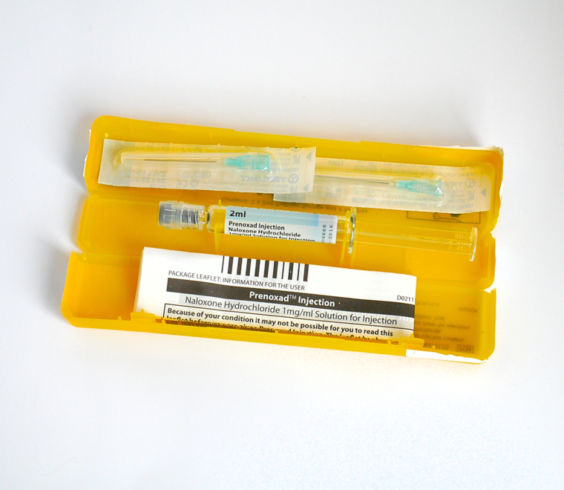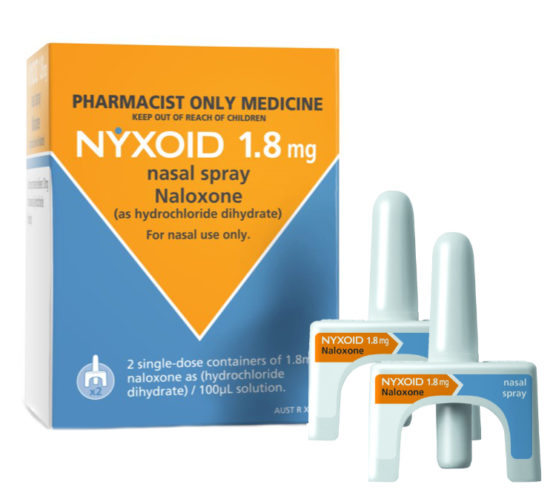
September 27, 2021
A new quality improvement project at Sunshine Hospital Emergency Department aims to expand the provision of a potentially life-saving medication for the emergency treatment of opioid overdose.
Underpinned by the Western Health Best Care framework, this project is a collaboration between Drug Health Services, Pharmacy, and Emergency Medicine, and aims to address an unmet need in a vulnerable population.
What is Take-Home Naloxone?
Naloxone is an opioid antagonist that rapidly reverses an opioid overdose. Take-home naloxone (THN) refers to pre-filled products for emergency administration by laypersons in a community setting. In the same way that we provide EpiPens to patients at risk of anaphylaxis, or emergency medications for people with diabetes, THN is a harm reduction approach to reducing the acute risks associated with having a chronic, relapsing health condition (opioid use disorder). At Western Health we have two THN products available, a nasal spray (Nyxoid) and a pre-filled syringe for intramuscular injection (Prenoxad).
What is a THN Program?
A THN program is simply the provision of THN and opioid overdose education to people at risk of experiencing or witnessing an opioid overdose. Whilst we already provide THN to some patients in the ED, this project aims to expand the provision of THN by ensuring it is available at any time of day or night, and that an Alcohol and Other Drug (AOD) nurse does not have to be present to provide it. We are doing this by equipping ED doctors with the skills to provide overdose education to at-risk patients, adding THN to the after-hours medication cupboard, and providing THN kits free to patients at the point of discharge from the ED. A vast body of evidence (see Further Reading below) has demonstrated that THN programs are safe, feasible, and effective at reducing population mortality rates from opioid overdose.
Essentially, the more people who know how to recognise an opioid overdose and can respond to it with naloxone, and the more naloxone kits there are available in the community, the fewer deaths there will be. This project goes some way to removing some of the barriers to accessing THN. It might also help to reduce some of the stigma associated with accessing treatment for a substance use disorder, by treating opioid use disorder as a health problem with bio-psycho-social underpinnings. Providing a harm reduction intervention like THN can open up a dialogue with patients about their drug use in a non-judgemental way, which may in turn get them thinking about accessing other AOD treatments and services.
Why Sunshine ED?
We see hundreds of patients in the ED every year who are at risk of opioid overdose, either because they have an opioid use disorder, or because they are prescribed multiple or high-dose opioid medications. The ED is an opportune setting to provide THN because we can reach at-risk patients who may not present to other healthcare settings. The 2021 Victorian Coroners report of overdose deaths found that Brimbank LGA had the highest number of heroin-related deaths in Victoria in 2020, so this very much a problem on our own doorstep. We also know that the single biggest risk factor for a fatal opioid overdose is a history of non-fatal overdose, so when we treat patients with an opioid overdose in the ED we have a window of opportunity to provide this intervention, and perhaps save a life.
This project will begin on Friday 1st October 2021, and run for 18 months. For more information speak to CNC Thomas Jones or EP Raj Patel.
Thomas Jones
Clinical Nurse Consultant (AOD)
E: thomas.jones@wh.org.au
P: 0466 806 708
Further Reading
Clark, A. K., Wilder, C. M., & Winstanley, E. L. (2014). A systematic review of community opioid overdose prevention and naloxone distribution programs. Journal of Addiction Medicine, 8(3), 153-162.
https://journals.lww.com/journaladdictionmedicine/Abstract/2014/05000/A_Systematic_Review_of_Community_Opioid_Overdose.1.aspx
European Monitoring Centre for Drugs and Drug Addiction. (2015). Preventing fatal overdoses: A systematic review of the effectiveness of take-home naloxone, EMCDDA Papers. https://www.emcdda.europa.eu/publications/emcdda-papers/naloxone-effectiveness_en
McAuley, A., Aucott, L., & Matheson, C. (2015). Exploring the life-saving potential of naloxone: A systematic review and descriptive meta-analysis of take home naloxone (THN) programmes for opioid users. International Journal of Drug Policy, 26(12), 1183-1188. https://www.sciencedirect.com/science/article/abs/pii/S0955395915003060?via%3Dihub
McDonald, R., & Strang, J. (2016). Are take-home naloxone programmes effective? Systematic review utilizing application of the Bradford Hill criteria. Addiction, 111(7), 1177-1187.
https://www.ncbi.nlm.nih.gov/pmc/articles/PMC5071734/
World Health Organization. (2014). Community management of opioid overdose.
https://www.who.int/publications/i/item/9789241548816
World Health Organization. (2020). Opioid overdose. https://www.who.int/news-room/fact-sheets/detail/opioid-overdose
News



